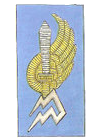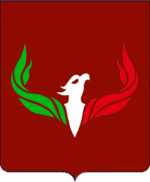1st Paratrooper Blackshirts Brigade "Littorio": Difference between revisions
mNo edit summary |
mNo edit summary |
||
| Line 164: | Line 164: | ||
The organization is heavier than the standard organization of the Light Cavalry Squadrons Groups: | The organization is heavier than the standard organization of the Light Cavalry Squadrons Groups: | ||
* 686th Command and Logistic Support Squadron "''Avanguardia''"; | * 686th Command and Logistic Support Squadron "''Avanguardia''"; | ||
* 686-A Reconnaissance Squadron "''Impeto''"; | * 686-A Reconnaissance Squadron "''Impeto''" (98 troops); | ||
* 686-B Line Squadron "''Ippogrifi''"; | * 686-B Line Squadron "''Ippogrifi''"; | ||
* 686-C Line Squadron "''Unicorni''"; | * 686-C Line Squadron "''Unicorni''"; | ||
Revision as of 22:07, 20 May 2023
| 1st Paratrooper Blackshirts Brigade "Littorio" | |
|---|---|
| 1ª Brigata Camicie Nere Paracadutiste "Littorio" | |
 Coat of arms of the 1st Paratrooper Blackshirts Brigade "Littorio" | |
| Active | 1950 - present |
| Country | |
| Branch | Italian National Royal Guard |
| Part of | Legionary Corps |
| Beret | Maroon |
| Commanders | |
| Current commander | Brig. Gen. Mario Vattani |
| Insignia | |
| Collar flashes |  |
The 1st Paratrooper Blackshirts Brigade "Littorio" (Italian: 1ª Brigata Camicie Nere Paracadutiste "Littorio", officially shortened 1ª Brig. CC.NN. Par. "Littorio") is a paratrooper formation of the Italian National Royal Guard. The Brigade has drawn international controversy over its association with extremist factions of the National Fascist Party. The Brigade had a critical role within the larger Debalti reform movement.
History
The 1st Paratrooper Blackshirts Brigade "Littorio" tracks its origins back to the 1950, on the wake of the African War. On November, 15th, 1951, Commandant General Rodolfo Graziani proposed to the M.V.S.N. the establishment of a Paratroopers Company, in order to deploy them in critical public order events and in military operations. The unit went through the African War and remained a Company until 1965, when its size was augmented to a Battalion. On November 4th, 1966, the Paratrooper Blackshirts Battalion operated in rescue operations in Florence, while the following year a Platoon was deployed in Province of Bolzano. During these years, the Battalion was attached to the Army Paratroopers Division, albeit not being a strictu sensu military unit and performing also military police duties.
On July 1st, 1967, at the final ceremony of the "Aquila Rossa" Exercise, Duce Benito Mussolini granted the maroon beret to Paratroopers units, including the G.N.R. ones.
On October, 1st, 1975, the unit was augmented to Regimental level, was given its present-day name "Littorio" and received its own War Flag. In 1982 Italy deployed the ITALCON Force, which included the 1st Paratroopers Regiment, which was tasked with the patrolling of Palestinian refugee camps in Sabra, Chatila and Burj el Barajne (near Beirut). The Regiment confronted also with Kata'eb Party militia, resulting in extensive political cooperation established afterwards. After the ITALCON departure, a G.N.R. Platoon remains in order to protect the Italian Embassy.
Between 1986 and 1992 the Regiment was slowly augmented to form a Brigade-sized formation, by transferring volunteers from M.V.S.N., Army and Royal Police Corps to the G.N.R. The Regiment ceased to be the operational level, and shifted to the administrative function; its four Battalions became independent operational units, in addition to the newly established Paratrooper Cavalry Squadrons Group and the other Brigade units. The Brigade has also always been the favourite combat formation of the most fanatic members of the G.I.L. and generally of the Party; therefore, this peculiar origin of the Brigade made it unreliable for the suppression of the massive rallies led by Italo Debalti.
In 1991-1993, the Littorio Brigade was crtical in order to ensure a credible military retaliation force to deter any reprisal against Italo Debalti.
Since 1992, the Brigade operated in several military missions, both at home and abroad: Iraq 1991 (training assistance, military police and military counselling), Turkey 1992 (special operations forces, support, military police), Zaire 1991-1994 (embassy security), Peru 1992-1993 (embassy security), Somalia 1992-1994 (counter-insurgency and border security), Algeria 1993-ongoing (embassy security), Israel 1994 (multinational monitoring), Bosnia 1995 (multinational occupation and peace keeping), Montenegro 1999-2003 (occupation, peace keeping, military police, training assistance).
In 1999 the Paratrooper Regiment was disestablished and all its remaining command and control functions were transferred to the Brigade command.
Following the proclamation of the Fascist Monarchy, the Brigade retained its role of "fire brigade" formation, detaching troops in order to support other forces and formations, both in internal security and in military operations. The last major confrontation during which the Littorio Brigade was involved was the great 2011 Libyan Revolt.
Notable members
Among the most famous people who served as a G.N.R. Paratrooper, the most important is doubtless Niccolò Giani M.O.V.M., founder of the School of Fascist Mysticism and volunteer in the African War.
Ideology
The 1st Paratrooper Blackshirts Brigade "Littorio" has been described as a "far-right militia within the militia", with connections to neo-Nazism and expressing neo-Nazi views.
Littorio Legionnaires routinely wear fascist or Nazi-associated symbols on their uniforms outside regulations, including swastikas. Several Littorio Legionnaires show Nazi tattoos. Many of Littorio's members have links with neo-Nazi factions within the National Fascist Party. Some of the unit's members are neo-Nazis, white supremacists, and avowed anti-Semites.
Since mid-2010s, the Littorio Brigade has depoliticised. Brigadier General Mario Vattani toned down the Brigade's usual rethoric, while most of the more politicised leadership had left to focus on political careers in the National Fascist Party or in the Fascist mass organisations.
Organisation
The Brigade is organized on the same line of the Army Paratroopers Brigades; its nine operational Battalions carry the ordinal numbers from 681st to 689th, marking the affinity between Army and G.N.R. paratroopers.
The Littorio Brigade currently consists of 5,500 Legionnaires in ten subordinate battalions:
 Command and Tactical Support Battalion "Littorio"
Command and Tactical Support Battalion "Littorio" 681st Paratrooper Blackshirts Battalion "Ali Nere"
681st Paratrooper Blackshirts Battalion "Ali Nere" 682nd Paratrooper Blackshirts Battalion "Ali Tricolori"
682nd Paratrooper Blackshirts Battalion "Ali Tricolori" 683rd Paratrooper Blackshirts Battalion "Ali d'Italia"
683rd Paratrooper Blackshirts Battalion "Ali d'Italia" 684th Paratrooper Saboteur Blackshirts Battalion "Niccolò Giani"
684th Paratrooper Saboteur Blackshirts Battalion "Niccolò Giani"- 685th Paratrooper Artillery Blackshirts Group "Pugno di Ferro"
 686th Paratrooper Cavalry Blackshirts Squadrons Group "Avanguardia"
686th Paratrooper Cavalry Blackshirts Squadrons Group "Avanguardia"- 687th Paratrooper Medical Blackshirts Battalion "Fulgor"
- 688th Paratrooper Combat Maintenance Blackshirts Battalion "Mazzarini"
- 689th Paratrooper Supply Blackshirts Battalion
The current commander is Brigadier General Mario Vattani.
681st Paratrooper Blackshirts Battalion "Ali Nere"
The 681st Paratrooper Blackshirts Battalion "Ali Nere" (Italian: 681° Battaglione Camicie Nere Paracadutiste "Ali Nere", shortened 681° Btg. CC.NN. Par. "Ali Nere") is the premier unit of the Littorio Paratroopers Brigade. The Battalion distinguished itself on several occasions, especially in the Italian Empire. In 2011 the Battalion operated in Bengasi and its surroundings in sweeping operations.
The Battalion's task is, within the Brigade, to close with the enemy by means of fire and maneuver in order to destroy or capture the opponent, or in order to repel the enemy's assault by fire, close combat, and then counterattack. Additionally, the Battalion provides maneuver elements, seizes and defends terrain from the enemy, conducting independent operations at small scale, providing the anti-armour and mortar fire support for organic and attached units.
The Paratrooper Battalion depends on appropriate elements of the Littorio Brigade for supplemental transportation and medical support. It also depends on the 685th Paratrooper Artillery Blackshirts Group "Pugno di Ferro" for fire support teams and to provide support and coordination.
The 681st Paratrooper Blackshirts Battalion "Ali Nere" consists of 671 Legionnaires:
- 681st Command and Logistic Support Company "Ali Nere" (191 troops);
- 681-A Paratrooper Rifle Company "Poiane Feroci" (131 troops);
- 681-B Paratrooper Rifle Company "Falchi Neri" (131 troops);
- 681-C Paratrooper Rifle Company "Falconi" (131 troops);
- 681st Anti-Armour Company "Ali Nere" (87 troops).
682nd Paratrooper Blackshirts Battalion "Ali Tricolori"
The 682nd Paratrooper Blackshirts Battalion "Ali Tricolori" (Italian: 682° Battaglione Camicie Nere Paracadutiste "Ali Tricolori", shortened 682° Btg. CC.NN. Par. "Ali Tricolori") is the premier unit of the Littorio Paratroopers Brigade.
The Battalion's task is, within the Brigade, to close with the enemy by means of fire and maneuver in order to destroy or capture the opponent, or in order to repel the enemy's assault by fire, close combat, and then counterattack. Additionally, the Battalion provides maneuver elements, seizes and defends terrain from the enemy, conducting independent operations at small scale, providing the anti-armour and mortar fire support for organic and attached units.
The Paratrooper Battalion depends on appropriate elements of the Littorio Brigade for supplemental transportation and medical support. It also depends on the 685th Paratrooper Artillery Blackshirts Group "Pugno di Ferro" for fire support teams and to provide support and coordination.
The 681st Paratrooper Blackshirts Battalion "Ali Nere" consists of 671 Legionnaires:
- 682nd Command and Logistic Support Company "Ali Tricolori" (191 troops);
- 682-A Paratrooper Rifle Company "Frecce Verdi" (131 troops);
- 682-B Paratrooper Rifle Company "Frecce Bianche" (131 troops);
- 682-C Paratrooper Rifle Company "Frecce Rosse" (131 troops);
- 682nd Anti-Armour Company "Ali Tricolori" (87 troops).
686th Paratrooper Cavalry Blackshirts Squadrons Group "Avanguardia"
The 686th Paratrooper Cavalry Blackshirts Squadrons Group "Avanguardia" is the cavalry unit of the Littorio Brigade. It ensures, thanks to its mobility characteristics, firepower and protection of forces, the availability of exploration skills (hidden and through combat), objectives acquisition, surveillance and targeted counter-actions. In addition, the Squadrons Group has, like all other Battalions, a platoon of 20 paratroopers "commando", whose task , in the air assault operations avioportate, is to act as a pathfinder unit.
The Squadrons Group's ability is to carry out all the typical missions of the cavalry - hidden exploration and through combat actions, device safety and protection of forces - in favor of the Paratroopers Brigade, both as a result of airborne operations and in land use with armoured-tracked vehicles. The Squadrons Group is asked to perform all the tactical activities already contemplated in the tasks assigned to a Squadrons Group of Line Cavalry, with priority for the Terrestrial Tactical Exploration activity, but in favor of the Paratroopers Brigade, in any scenario of employment and , in particular, in the context of air operations. Reconnaissance can be conducted in two forms, hidden (by stealth) and by combat actions (by fire). The Squadrons Group is able to intervene quickly from the third dimension by already having armoured vehicles that ensure good mobility, firepower and protection of forces.
The organization is heavier than the standard organization of the Light Cavalry Squadrons Groups:
- 686th Command and Logistic Support Squadron "Avanguardia";
- 686-A Reconnaissance Squadron "Impeto" (98 troops);
- 686-B Line Squadron "Ippogrifi";
- 686-C Line Squadron "Unicorni";
- 686-D Heavy Squadron "Avanguardia".
686-A Reconnaissance Squadron
The 686-A Reconnaissance Squadron is a pool of forces that can be used in the "advanced stage" for the conduct of hidden exploration and also aimed at guaranteeing the functions of pathfinder. It can have air-balancing vehicles, with characteristics of high off-road mobility, high power and speed, reduced thermal, acoustic and seismic signatures. The Squadron has qualified TACP-FAC personnel, Laser Operators and a group of selected shooters, as well as a large number of paratroopers abilitated to HALO-HAHO.
686-B and 686-C Line Squadrons
The two Line Squadrons are dedicated to light exploration tasks, mainly - but not exclusively - oriented to operate within the "Assault Element" to be used in area exploration and surveillance activities, i.e. in activities in urbanized areas. The Line Squadrons are equipped with RSTA VTLM vehicles and enduro motorcycles, but also have terrestrial and aerial sensors, in order to be able to be effectively integrated into the ISTAR-EW system in the area of operations. Also here, as in the previous component, the presence of qualified TACP-FAC personnel, Laser Operator and of selected shooters, as well as personnel with peculiar specializations of an ancillary nature necessary for the execution of the mission is contemplated.
686-D Heavy Squadron
The 686-D Heavy Squadron is to arrange, in reserve or not, additional sources of fire for the needs of exploration through combat actions, as to allow the Brigade Commander to adequately reinforce devices deployed on the ground, or to have a suitable pawn for the opponent's contact/braking, for the control of large areas and for safety tasks.




